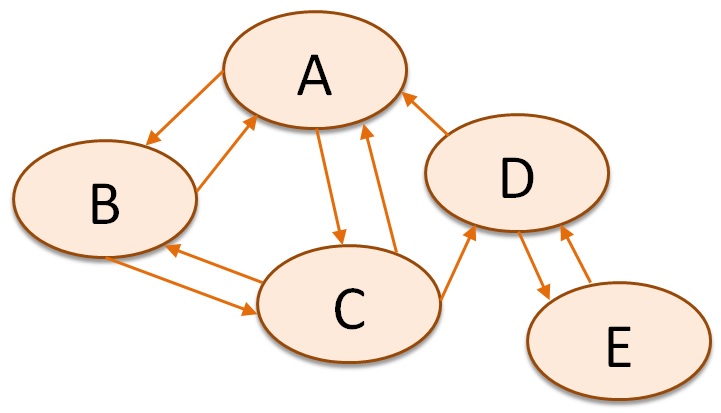|
Informetrics
Informetrics is the study of quantitative aspects of information, it is an extension and evolution of traditional bibliometrics and scientometrics. Informetrics uses bibliometrics and scientometrics methods to study mainly the problems of literature information management and evaluation of science and technology. Informetrics is an independent discipline that uses quantitative methods from mathematics and statistics to study the process, phenomena, and law of informetrics. Informetrics has gained more attention as it is a common scientific method for academic evaluation, research hotspots in discipline, and trend analysis. Informetrics includes the production, information dissemination, dissemination, and use of all forms of information, regardless of its form or origin. Informetrics encompasses the following fields: * Scientometrics, which studies quantitative aspects of science * Webometrics, which studies quantitative aspects of the World Wide Web * Bibliometrics, which studie ... [...More Info...] [...Related Items...] OR: [Wikipedia] [Google] [Baidu] |
Ronald Rousseau
Ronald Rousseau (Antwerp, 1949) is a Belgian mathematician and information scientist. He has obtained an international reputation for his research on indicators and citation analysis in the fields of bibliometrics and scientometrics. Education and career Ronald Rousseau obtained his doctorate in mathematics at the KU Leuven in 1977 and his doctorate in documentation and library science at the UIA in 1992. He was Professor of Mathematics at the Department of Industrial Science and Technology at the KHBO in Ostend, Belgium. Rousseau has focused his research on the development and use of indicators to measure the quality of research and main trends in science. He is an expert in citation analysis and research evaluation. In 1990 Ronald Rousseau and Leo Egghe wrote the first manual of bibliometrics. Rousseau has published more than 200 scientific articles on various aspects of bibliometrics and scientometrics in, among other journals, Scientometrics, Journal of the American S ... [...More Info...] [...Related Items...] OR: [Wikipedia] [Google] [Baidu] |
Webometrics
The science of webometrics (also cybermetrics) tries to measure the World Wide Web to get knowledge about the number and types of hyperlinks, structure of the World Wide Web and using patterns. According to Björneborn and Ingwersen, the definition of webometrics is "the study of the quantitative aspects of the construction and use of information resources, structures and technologies on the Web drawing on Bibliometrics, bibliometric and informetrics, informetric approaches." The term ''webometrics'' was first coined by Almind and Ingwersen (1997). A second definition of webometrics has also been introduced, "the study of web-based content with primarily quantitative methods for social science research goals using techniques that are not specific to one field of study", which emphasizes the development of applied methods for use in the wider social sciences. The purpose of this alternative definition was to help publicize appropriate methods outside the information-science discipli ... [...More Info...] [...Related Items...] OR: [Wikipedia] [Google] [Baidu] |
Scientometrics
Scientometrics is a subfield of informetrics that studies quantitative aspects of scholarly literature. Major research issues include the measurement of the impact of research papers and academic journals, the understanding of scientific citations, and the use of such measurements in policy and management contexts. Leydesdorff, L. and Milojevic, S., "ScientometricsarXiv:1208.4566(2013), forthcoming in: Lynch, M. (editor), ''International Encyclopedia of Social and Behavioral Sciences'' subsection 85030. (2015) In practice there is a significant overlap between scientometrics and other scientific fields such as information systems, information science, science of science policy, sociology of science, and metascience. Critics have argued that overreliance on scientometrics has created a system of perverse incentives, producing a publish or perish environment that leads to low-quality research. Historical development Modern scientometrics is mostly based on the work of Dere ... [...More Info...] [...Related Items...] OR: [Wikipedia] [Google] [Baidu] |
Tibor Braun
Tibor is a masculine Hungarian given name. * Originated shortened form of the medieval Hungarian name ''Tiborc''; which originates from the ancient Latin surname Tiburtius. * from Etruscan name Tibur, which means "honest man" Some notable people known by this name include: * Tibor Ág * Tibor Antalpéter * Tibor Benedek * Tibor Farkas * Tibor Feheregyhazi * Tibor Fischer * Tibor Gécsek * Tibor Hollo * Tibor Kalman * Tibor R. Machan * Tibor Mičinec * Tibor Nyilasi * Tibor Ordina * Tibor Őze Hungarian football manager * Tibor Parák * Tibor Pleiß * Tibor Polgár (1907–1993), Hungarian composer * Tibor Radó * Tibor Renyi * Tibor Selymes * Tibor Sisa Hungarian football manager * Tibor Stark * Tibor Szasz * Tibor Szele * Tibor Varga (ice hockey) * Tibor Varga (violinist) * Tibor Viniczai * Tibor Wlassics * Tibor Zsitvay See also * Ctibor (name) * ''Tibor'' is the Hungarian name for Tibru village, Cricău Commune, Alba County, Romania * TIBOR is the short nam ... [...More Info...] [...Related Items...] OR: [Wikipedia] [Google] [Baidu] |
Manfred Bonitz
''Manfred: A dramatic poem'' is a closet drama written in 1816–1817 by Lord Byron. It contains supernatural elements, in keeping with the popularity of the ghost story in England at the time. It is a typical example of Gothic fiction. Byron commenced this work in late 1816, a few months after the famous ghost-story sessions with Percy Bysshe Shelley and Mary Shelley that provided the initial impetus for '' Frankenstein; or, The Modern Prometheus''. The supernatural references are made clear throughout the poem. ''Manfred'' was adapted musically by Robert Schumann in 1848–1849, in a composition entitled '' Manfred: Dramatic Poem with Music in Three Parts'', and in 1885 by Pyotr Ilyich Tchaikovsky in his '' Manfred Symphony''. Friedrich Nietzsche was inspired by the poem's depiction of a super-human being to compose a piano score in 1872 based on it, "Manfred Meditation". Background Byron wrote this "metaphysical drama", as he called it, after his marriage to Annabella Mi ... [...More Info...] [...Related Items...] OR: [Wikipedia] [Google] [Baidu] |
Eugene Garfield
Eugene Eli Garfield (September 16, 1925 – February 26, 2017) was an American linguistics, linguist and businessman, one of the founders of bibliometrics and scientometrics. He helped to create ''Current Contents'', ''Science Citation Index'' (SCI), ''Journal Citation Reports'', and ''Index Chemicus'', among others, and founded the magazine ''The Scientist (magazine), The Scientist''. Early life and education Garfield was born in 1925 in New York City as Eugene Eli Garfinkle, his mother being of Lithuanian Jews, Lithuanian Jewish ancestry. His parents were second generation immigrants living in East Bronx in New York City. He studied at the University of Colorado and University of California, Berkeley before getting a Bachelor of Science degree in chemistry from Columbia University in 1949. Garfield also received a degree in Library Science from Columbia University in 1953. He went on to do his PhD in the Department of Linguistics at the University of Pennsylvania, which he comp ... [...More Info...] [...Related Items...] OR: [Wikipedia] [Google] [Baidu] |
3 Metric Terms
3 (three) is a number, numeral and digit. It is the natural number following 2 and preceding 4, and is the smallest odd prime number and the only prime preceding a square number. It has religious and cultural significance in many societies. Evolution of the Arabic digit The use of three lines to denote the number 3 occurred in many writing systems, including some (like Roman and Chinese numerals) that are still in use. That was also the original representation of 3 in the Brahmic (Indian) numerical notation, its earliest forms aligned vertically. However, during the Gupta Empire the sign was modified by the addition of a curve on each line. The Nāgarī script rotated the lines clockwise, so they appeared horizontally, and ended each line with a short downward stroke on the right. In cursive script, the three strokes were eventually connected to form a glyph resembling a with an additional stroke at the bottom: ३. The Indian digits spread to the Caliphate in the 9th c ... [...More Info...] [...Related Items...] OR: [Wikipedia] [Google] [Baidu] |
Library Science
Library and information science (LIS)Library and Information Sciences is the name used in the Dewey Decimal Classification for class 20 from the 18th edition (1971) to the 22nd edition (2003). are two interconnected disciplines that deal with information management. This includes organization, access, collection, and regulation of information, both in physical and digital forms.Coleman, A. (2002)Interdisciplinarity: The Road Ahead for Education in Digital Libraries D-Lib Magazine, 8:8/9 (July/August). Library science and information science are two original disciplines; however, they are within the same field of study. Library science is applied information science. Library science is both an application and a subfield of information science. Due to the strong connection, sometimes the two terms are used synonymously. Definition Library science (previously termed library studies and library economy) is an interdisciplinary or multidisciplinary field that applies the practices, per ... [...More Info...] [...Related Items...] OR: [Wikipedia] [Google] [Baidu] |
Bibliometrics
Bibliometrics is the application of statistical methods to the study of bibliographic data, especially in scientific and library and information science contexts, and is closely associated with scientometrics (the analysis of scientific metrics and indicators) to the point that both fields largely overlap. Bibliometrics studies first appeared in the late 19th century. They have known a significant development after the Second World War in a context of "periodical crisis" and new technical opportunities offered by computing tools. In the early 1960s, the Science Citation Index of Eugene Garfield and the citation network analysis of Derek John de Solla Price laid the fundamental basis of a structured research program on bibliometrics. Citation analysis is a commonly used bibliometric method based on constructing the citation graph, a network or graph representation of the citations shared by documents. Many research fields use bibliometric methods to explore the impact of their ... [...More Info...] [...Related Items...] OR: [Wikipedia] [Google] [Baidu] |
Gerard Salton
Gerard A. "Gerry" Salton (8 March 1927 – 28 August 1995) was a professor of computer science at Cornell University. Salton was perhaps the leading computer scientist working in the field of information retrieval during his time, and "the father of Information Retrieval". His group at Cornell developed the SMART Information Retrieval System, which he initiated when he was at Harvard. It was the first system to use the now popular vector space model for information retrieval. Education and career Salton was born Gerhard Anton Sahlmann in Nuremberg, Germany. He came to the United States in 1947 and was naturalized in 1952. He received a Bachelor's (1950) and Master's (1952) degree in mathematics from Brooklyn College, and a Ph.D. from Harvard in applied mathematics in 1958, the last of Howard Aiken's doctoral students, and taught there until 1965, when he joined Cornell University and co-founded its department of Computer Science. Salton was perhaps most well known for develop ... [...More Info...] [...Related Items...] OR: [Wikipedia] [Google] [Baidu] |
Metascience
Metascience (also known as meta-research) is the use of scientific methodology to study science itself. Metascience seeks to increase the quality of scientific research while reducing inefficiency. It is also known as "research on research" and "the science of science", as it uses research methods to study how research is done and find where improvements can be made. Metascience concerns itself with all fields of research and has been described as "a bird's eye view of science". In the words of John Ioannidis, "Science is the best thing that has happened to human beings... but we can do it better." In 1966, an early meta-research paper examined the statistical methods of 295 papers published in ten high-profile medical journals. It found that "in almost 73% of the reports read... conclusions were drawn when the justification for these conclusions was invalid." Meta-research in the following decades found many methodological flaws, inefficiencies, and poor practices in research ac ... [...More Info...] [...Related Items...] OR: [Wikipedia] [Google] [Baidu] |





